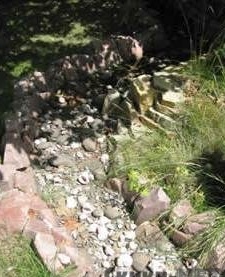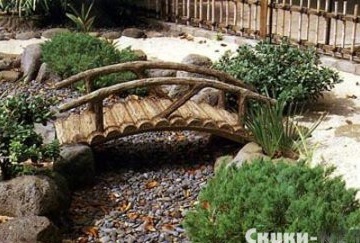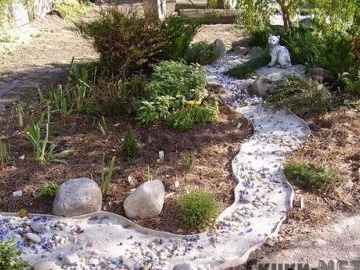
The very concept of a "dry stream" came to us from Japan. Over time, this element of landscape design has spread to Europe, penetrating into any design styles of gardens and parks. It will be quite appropriate not only in the Japanese garden, but also in country or English - it all depends on the selection of elements (stream materials, shape framing plants). And if you follow the style requirements, then a dry stream will not be redundant in the garden with a regular layout.
If you create a dry stream is shallow, it seems that the water has dried just literally - good rain, and a dry stream will become very wet. Having located a stream channel on the site, it is possible to solve several problems in one fell swoop: to connect different zones, hide unaesthetic structures, such as drainage hatches, with pebbles and stones. Yes, and the creek itself is able to replace the drainage ditch.
In addition, caring for a dry stream is much easier than for a "wet" one. Neither eternal trouble with the extermination of algae, nor clogging of the water supply, nor a complex and expensive system for pumping water.
Now let's see how to make a dry creek do it yourself. First, you should plan the shape of the channel of the future stream. In this case, the shape of the site itself should be taken into account. A narrow brook with many bends visually deepens the space, making the small garden look more spacious.
For a visual representation of the location of the channel, pour sand where you intend to lay it. See how it will look. Perhaps adjust the shape. Choosing a contour in this way, you will find the most suitable option for your garden without extra costs.
Having decided on the form, you should deal with stones. They can be either large or small, or make up a mixture of stones of different sizes. You can pick up stones of different colors. For example, gneiss, slate or basalt have a light blue color, marble or limestone - painted in bright colors, and a reddish-brown shade can be obtained using granite. Often add glass granules that reflect light and create the illusion of water.In addition, there is a special varnish for stones, providing the illusion of a wet surface.
Then you can do it directly building stream.
Along the contour of the channel, you need to dig a ditch, cover it with geotextile or lutrasil to prevent grass growth. These materials are permeable to air and water, but not to light, they will not allow gravel to go into the soil. Then we begin to lay out the stones. Larger - along the coast, smaller - in the mainstream. When creating a dry stream, it is preferable to use two types of stone (for example, naked and buty), or the same varieties that were used to decorate the site or house. As a decorative filler, fine pebbles, marble chips, or even sand, on which using a bamboo rake create a wave-like pattern, are suitable.
It remains to arrange plants along the river bed, for example, young plants, thyme or decorative varieties of barberry. However, the choice will be determined by your preferences, as well as the style of the garden, lighting, soil, etc.
That's all - you can brag to your friends with a real dry stream!


